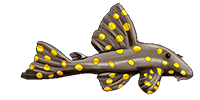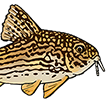| Scientific Name | Calophysus macropterus (Lichtenstein, 1819) |
| Common Names | Vulture Catfish Bagre Machete (Venezuelan), Gribbemalle (Denmark), Mapurite (Venezuelan), Pintadinho (Brazilian), Piracatinga (Brazilian), Pirate Catfish, Zamurito (Venezuelan) |
| Type Locality | Brazil. |
| Synonym(s) | Pimeletropis lateralis, Pimeletropsis lateralis, Pimelodes macropterus, Pimelodus ctenodus, Pimelodus macropterus |
| Pronunciation | mack row terr uss |
| Articles | |
| Size | 400mm or 15.7" SL. Find near, nearer or same sized spp. |
| Identification | Body somewhat elongate and head broad. Eyes superior. Barbels flattened with maxillary pair extending past the end of the adipose fin. First dorsal and pectoral fin rays are 'soft'. Number of spots on the body varies greatly between populations. |
| General Remarks | This fish has at times been placed in its own family, the Calophysidae. Although it externally looks much like other pimelodids its unique dentition, different positioning of the fins from other pimelodids, and reduced and encased swim bladder make it a distant relative of the other pimelodids. |
| Distribution | South America: Amazon and Orinoco River basins. Amazon (click on these areas to find other species found there) Amazon, Middle Amazon (Solimoes), Purus, Caeté (Acre) (click on these areas to find other species found there) Amazon, Lower Amazon, Nhamundá (click on these areas to find other species found there) Amazon, Middle Amazon (Solimoes), Madeira, Canumã, Sucundurí (click on these areas to find other species found there) Login to view the map. |
| IUCN Red List Category | Least Concern , range map and more is available on the IUCN species page. Last assessed 2020. |
| pH | 6.0 - 7.4 |
| Temperature | 24.0-29.0°C or 75.2-84.2°F (Show species within this range) |
| Feeding | An adaptable carnivore as the common name, 'vulture catfish' applies. User data. |
| Furniture | Comfortable in almost any environment, including sturdy planted aquaria, provided it has sufficient hiding places. |
| Compatibility | A true scavenger that is also a vicious predator. Its unique dentition allows it to bite other fishes and remove chunks of flesh. Often attacks the catch of fishermen while they are hooked or netted. This ability has given the name bagre matchete (machete catfish) in Venezuela and Colombia. They are so vicious in their attacks that they sometimes stay attached even when their prey is removed from the water. Tankmates should be chosen with great care. While it appears this fish mainly attacks wounded fishes, it certainly has the ability to rip any tankmate to shreds should it desire to do so. |
| Suggested Tankmates | Armored loricariids and doradids, larger fish such as cichlids. |
| Breeding | Unreported. |
| Breeding Reports | There is no breeding report. |
| Reference | Zoologisches Magazin (Wiedemann) 1819, v. 1 (pt 3), pp 59. |
| Registered Keepers | There are 25 registered keepers, view all "my cats" data. |
| Wishlists | Love this species? Click the heart to add it to your wish list. There are 2 wishes to keep this species, see who wants what. |
| Spotters | Spotted this species somewhere? Click the binoculars! There are 11 records of this fish being seen, view them all. |
| Forum BBCode | |
| Search for C. macropterus | |
| Look up C. macropterus on AquaticRepublic.com | |
 | Look up C. macropterus on Fishbase |
 | Look up C. macropterus on Encyclopedia of Life |
 | Look up C. macropterus on Global Biodiversity Information Facility |
| LFS label creator ARN ref:1.15.118.336 | |
| Last Update | 2025 Jan 02 01:36 (species record created: 2001 Apr 22 00:00) |





/siluriformes/pimelodidae/calophysus/macropterus/1.jpg)
/siluriformes/pimelodidae/calophysus/macropterus/2.jpg)
/siluriformes/pimelodidae/calophysus/macropterus/3.jpg)
/siluriformes/pimelodidae/calophysus/macropterus/4.jpg)
/siluriformes/pimelodidae/calophysus/macropterus/5.jpg)
/siluriformes/pimelodidae/calophysus/macropterus/6.jpg)
/siluriformes/pimelodidae/calophysus/macropterus/7.jpg)
/siluriformes/pimelodidae/calophysus/macropterus/8.jpg)
/siluriformes/pimelodidae/calophysus/macropterus/9.jpg)
/siluriformes/pimelodidae/calophysus/macropterus/10.jpg)
/siluriformes/pimelodidae/calophysus/macropterus/11.jpg)
/siluriformes/pimelodidae/calophysus/macropterus/12.jpg)
/siluriformes/pimelodidae/calophysus/macropterus/13.jpg)
/siluriformes/pimelodidae/calophysus/macropterus/14.jpg)
/siluriformes/pimelodidae/calophysus/macropterus/15.jpg)
/siluriformes/pimelodidae/calophysus/macropterus/16.jpg)
/siluriformes/pimelodidae/calophysus/macropterus/17.jpg)
/siluriformes/pimelodidae/calophysus/macropterus/18.jpg)
/siluriformes/pimelodidae/calophysus/macropterus/19.jpg)
/siluriformes/pimelodidae/calophysus/macropterus/20.jpg)
/siluriformes/pimelodidae/calophysus/macropterus/21.jpg)
/siluriformes/pimelodidae/calophysus/macropterus/22.jpg)
/siluriformes/pimelodidae/calophysus/macropterus/23.jpg)
/siluriformes/pimelodidae/calophysus/macropterus/24.jpg)
/siluriformes/pimelodidae/calophysus/macropterus/25.jpg)
/siluriformes/pimelodidae/calophysus/macropterus/26.jpg)